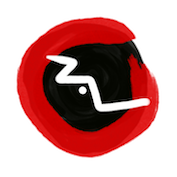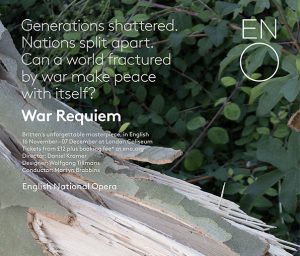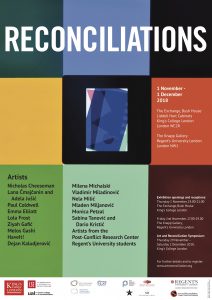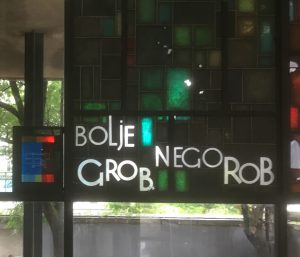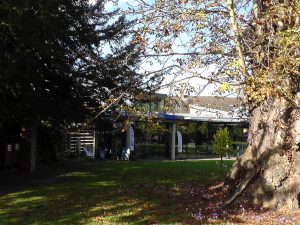‘in a different light’
Site-specific installation consisting of 5 analogue black & white photographs in mounts, 5 digital colour photographs in mounts and 5 photographic and text collages in mounts, Par light, 2019
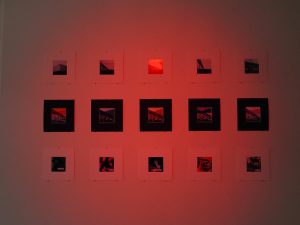
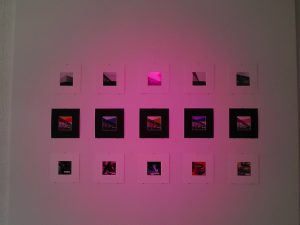
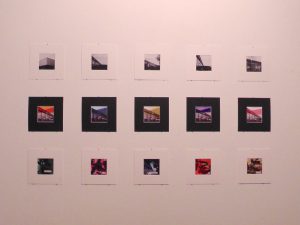
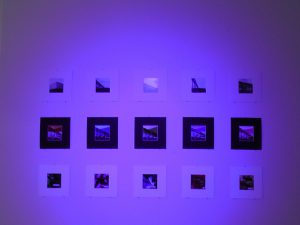
The Museum of the Revolution, as it was initially called, was ‘based on contemporary museological principles within contemporary architectonic forms.’ This installation reflects on the shifting significance of this for the History Museum, as it is today, over half a century later.
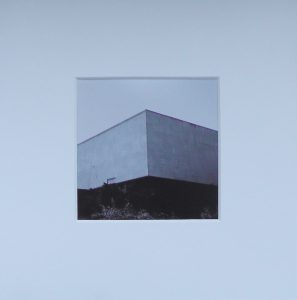
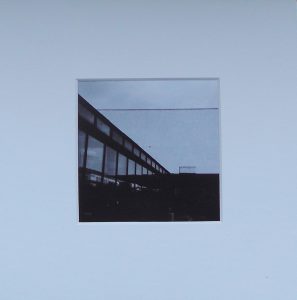

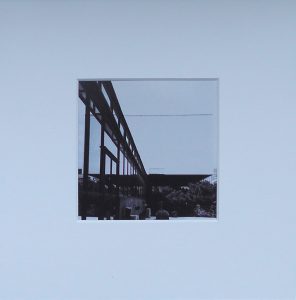

I took the photographs in this exhibition in July this year, during my residency at the Museum. I shot the black and white section on analogue 35mm film, whereas the pictures shot partially through coloured filters are digital. The latter also
feature in the collages.
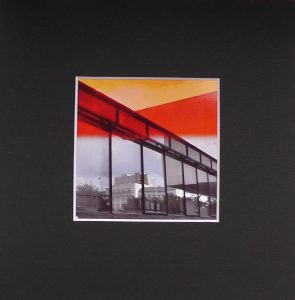




The text spread across the collages, ‘coloured glass destroys all hatred’, is a phrase from Paul Scheerbart’s 1914 treatise Glass Architecture, in which he imagined a utopian future filled with cities of crystal, and floating continents of chromatic glass. Scheerbart’s ideas on the link between glass architecture and a better future society influenced architects and writers, including Bruno Taut, Walter Benjamin and Mies van der Rohe. An early article on the Museum of the Revolution labels it in the style of ‘Mies’, because of its modernist steel and glass construction. ’in a different light’ alludes to this early modernist period, visually, but also to the mid-1960s, as the collages with text relate specifically to Vojo Dimitrijevic’s abstract stained glass artwork with the slogan ‘Death to Fascism’.
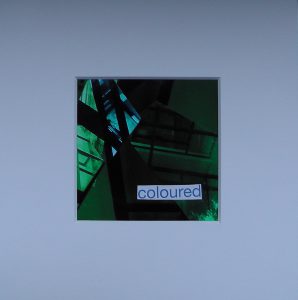
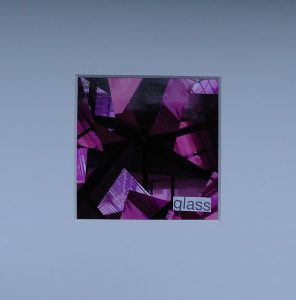

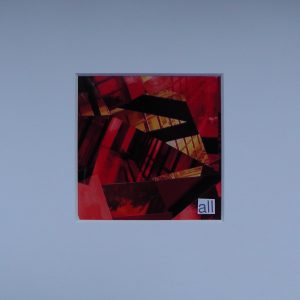

The History Museum building may be stylistically of its time, but perhaps the ‘living’ Museum is ahead of its time? Of the past, yet for the future.
‘in a different light’ work in progress
My site specific installation at the History Museum of BiH, Sarajevo, opens on 1 November 2019, the start of ‘Museum Month’ there.

My pre-installation publicity material for ‘in a different light’
I have taken all my materials to Sarajevo and am working right up to the wire making collages and working out how best to install the work. I am thrilled that the Museum curator Elma Hodzic has suggested we re-locate the Par light Brian Eno donated after his abstract piece ’77 Million Paintings’ was shown upstairs in the ‘cube’ at the Museum last year, so that it can literally show my works ‘in a different light’, in the ground floor location we have chosen.
‘We build the tracks, the tracks build us’ opening
Museum Director Elma Hasimbegovic, Dr. Rachel Kerr, Prof. James Gow Dr. Paul Lowe
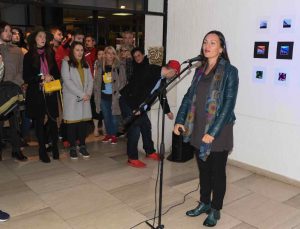
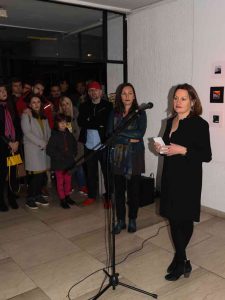


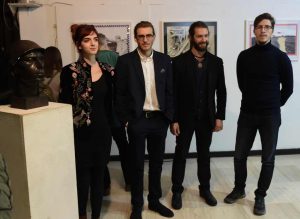
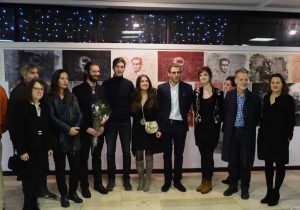
Artists Marina, Stefan, Ensar & Faris Artists and project team members
‘Mi gradimo prugu, pruga gradi nas’ / ‘We build the tracks, the tracks build us’
History Museum of BiH, Sarajevo, 1-24 November 2019
This exhibition by Ensar Hadzic, Faris Ramadanovic, Stefan Savic and Marina Krsmanovic, is the result of ‘The Living Museum’ Open Call.
The artists have chosen works from the Museum’s art collection and have created new works in response.
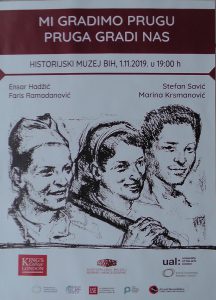
Extracts from Museum Curator Elma Hodzic’s text on the exhibition:
‘Over the past several months, students from the Department of Graphics at the Academy of Fine Arts in Sarajevo have carried out research in the Museum, engaging with it both artistically and curatorially: analysing themes, stylistic techniques, selecting works, integrating works within a unified thematic and curatorial framework, and ultimately producing their own powerful works of art.’
‘Bringing together the Museum’s stories of war, industrialisation and everyday life, with the phenomena and problems of today’s society, the artists and curators of this exhibition have built a bridge between what has passed in to history, and what will one day become history. Through this act, which bridges the chasm between socialism, as a historical phase, and contemporary life, the students and curators help the Museum take on the label which it should always have: THE LIVING MUSEUM!’
‘Contemporary ConTEXTS: Re-Imagining Socialist Images’
History Museum of BiH, Sarajevo, 10 October – 29 November 2019
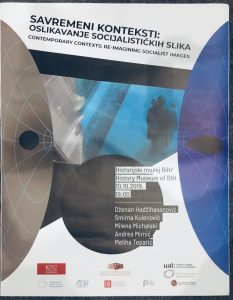
Curator: Elma Hodžić
Artists: Dženan Hadžihasanović, Smirna Kulenović, Milena Michalski, Andrea Mirnić, Meliha Teparić
Essay: Tatjana Nikolić
English translation of this and other Bosnian press articles:
https://artreconciliation.org/english-translation-of-bosnian-press/
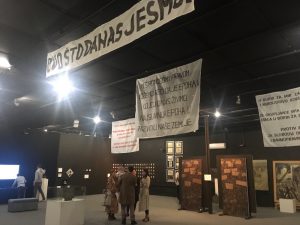
Tito Through Time
Installation of my photographs of the Tito sculpture in the History Museum and my prints from the Museum’s archival negatives of a bust of Tito.

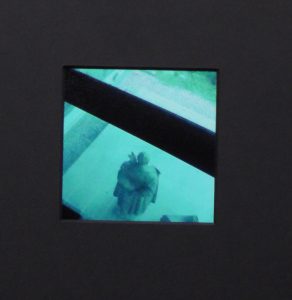
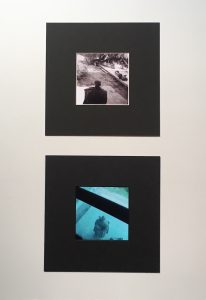

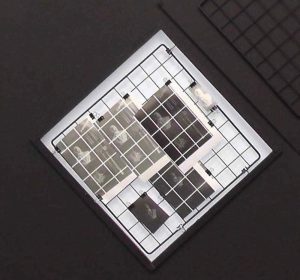

Developing Images
Installation with my hand-printed positive and negative photographs of Tito’s son, Žarko Broz, which were printed from the Museum’s archival glass plate negative.
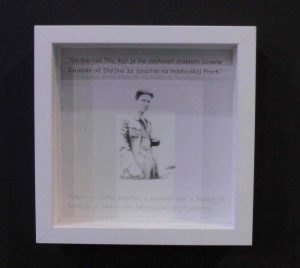
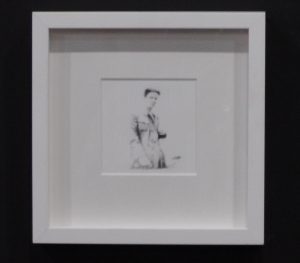
Sketchbook / notebook from my History Museum residency in July 2019
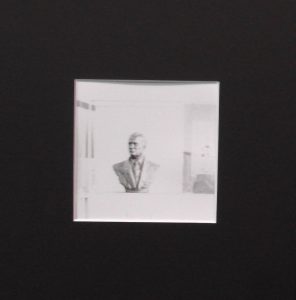

Fragments of prints from negatives of a Tito sculpture, developed differently
The Residency and the works:
The overall concept of the project of which this exhibition, ‘Contemporary ConTEXTS: Re-Imagining Socialist Images’, is part, is ‘The ‘Living Museum’. My work places the emphasis on both parts of this phrase. I approached the idea of the Museum specifically with the photographic archive in mind, and found one possible way to make it ‘live’. I immersed myself in the darkroom of the ‘foto depo’ (photo depot) during my time as Artist in Residence at the Museum in July, closing myself off in the dark with a very limited number of negatives and glass plates, and choosing to work with only those, rather than seeking further content, context or explanatory documentation from the archives.

Working with the reproduction of photographs for creative purposes, whether by analogue or digital means, inevitably calls to mind Walter Benjamin’s ideas on ‘The Work of Art in the Age of Its Technological Reproducibility’. I set myself the task of experimentation, through printing from old glass plates and negatives from the Museum’s archive collection. My aim was to make analogue photographs in deliberately ‘imperfect’ and inconsistent ways, as a contrast to traditional, official, ‘perfectly’ developed prints. I was investigating how different versions of the same image might evoke different responses, suggest different connotations, through varying degrees of clarity, focus, colour, texture and size, amongst other qualities. Could these hand-printed photographs bring a new dimension to the traditional readings of the negatives’ historical, archival content? Through their unique aspects in these renewed forms, could they gain something beyond their original ‘documentary’ and propagandistic purpose?

The process of creating the works was as important as the finished pieces. Time spent in the darkroom — minutes, seconds and fractions of seconds carefully measured with a Durst Digitim 2000 enlarger timer, while the hours raced past unnoticed — was a kind of meditation, a slowing down, a chance to think about the images on the glass plate and on film, and also about the damage these objects had sustained over the decades, and what had been preserved. The deterioration of the images through age, through war, through various difficult circumstances, gave them a layer of materiality which showed through on the print, along with any imperfections I introduced in printing.
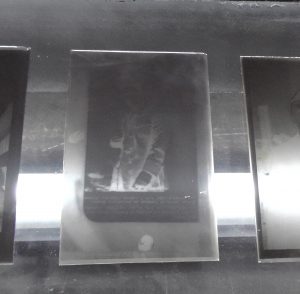
The damage sustained by the fragile film and glass negatives, as well as by some of the darkroom equipment, is a symbol of the wider damage inflicted on the archives, on the Museum and on the country and people over the decades, just as the passing of time is marked by the transition in medium from glass plate negative to film to digital.
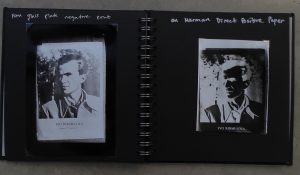
In the darkroom, I thought a great deal about context, text and meaning, about what an isolated image can convey, and what requires explaination for the content to be understood. I decided to play with the ‘legibility’ of the image by altering the print quality. The photographic terminology of ‘developing’ an image began to take on a more metaphorical meaning too. I developed some images on positive paper and some on negative, to bring together the literal darkroom colours and the philosophical or ideological concepts of positive and negative, black and white. The red glow of the safelight falling on the portraits of the Communist leader took on a certain ideological symbolism too. What might it mean to print and display this image in post-communist times, as opposed to under communism?

One of the first items in the foto depo that struck me was a glass negative plate. This was partly because I love glass plates as physical objects, but also because the text underneath the portrait on it said “Sin maršala Tita, koji je bio odlikovan ordenom Crvene Zvijezde od Staljina za junaštvo na moskovskoj fronti.” [“Marshall Tito’s son, to whom Stalin awarded the Order of the Red Star for heroism on the Moscow Front.”] I did not know of this son, and the plate did not name him. Through a quick internet search I found out he was Žarko Broz. I became intrigued as I discovered the whole story. A heroic picture of a handsome young man hid a tragic episode in Tito’s life, involving his first wife, Pelagia Belousova. Žarko’s mother was a Russian, whom Tito met in Siberia when she was extremely young. After Tito was arrested for political reasons she placed their son in children’s home in Moscow and re-married. Tito later managed to get him out. Pelagia ended up in a Soviet prison camp. This work became ‘Developing Images’, a reference both to the process of making the prints, and also to the life-trajectory of Tito’s son, from which a moment of glory was captured by the camera.
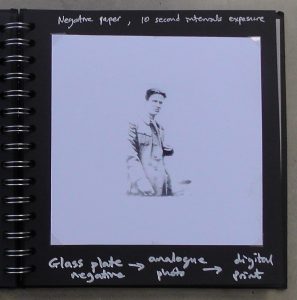
Tito and Pelagia’s story contrasts greatly with the idealised, glamorous photograph of Tito and Jovanka, his third and most famous and most photographed wife, seated, seemingly happily, on the leather armchairs in the History Museum. A chasm of time and context divides early and late Tito,. It divides his role as husband the first and the third, last time, and it divides his public and his private personas — the father of young Žarko, in the early 1930s, was hardly the same man as Marshall Tito, who visited the Museum in 1969.
Walter Benjamin recognizes the portrait as having a particular resonance in photography: “It is no accident that the portrait is central to early photography. In the cult of remembrance of dead or absent loved ones, the cult value of the image finds its last refuge. In the fleeting expression of a human face, the aura beckons from early photographs for the last time. This is what gives them their melancholy and incomparable beauty.” This, too, is a factor in my being drawn to the image of the lost-looking young man, Tito’s son.
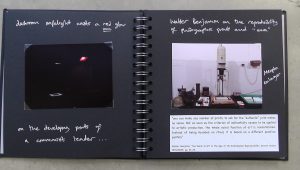
Benjamin discusses the medium of sculpture in contrast to that of photography. He states that a sculptural artwork has an ‘aura’, whereas photography does not. I relate this to my work making prints from a negative of a sculpture of Tito. Benjamin writes “[…] one can make any number of prints; to ask for the “authentic” print makes no sense. But as soon as the criterion of authenticity ceases to be applied to artistic production, the whole social function of art is revolutionized. Instead of being founded on ritual, it is based on a different practice: politics.” [Benjamin, The Work of Art, pp. 24-25]. Printing contemporary photographs from over half a century-old negatives, particularly when they record political sculptures, transforms the original political function. Although Benjamin explains that ‘[t]he uniqueness of the work of art is identical to its embeddedness in the context of tradition’, he clarifies that ‘[o]f course, this tradition itself is thoroughly alive and extremely changeable.’ [Benjamin, p. 24]. This brings us back to the ‘living’ Museum idea.
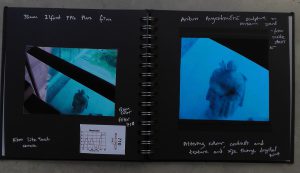
My photographs of Antun Augustinčić’s Tito sculpture in the yard suggest another kind of play on the idea of context. They show Tito almost hiding away in the yard, a survivor of times of war and political upheaval when the sculpture might have been damaged beyond recognition, or deliberately demolished. The sculpture is an important archival artefact, a starting point for future generations to explore their country’s history. The work with the blue tint is part of a series of photographs I took of the Museum using different colour filters, which will be shown in the History Museum as part of the next ‘Living Museum’ project exhibition.
My installation is a series of interventions, responses and experiments, where the process is laid bare to the public as an invitation to engage with the Museum and the archive, to encourage discussion and thought about old and contemporary ideologies and technologies, to provoke looking beyond the superficial image and reading between the lines. Unconventional prints arise from archival negatives, alternative visions are presented using traditional museum statuary.
My fragments of portraits and my noted-down thoughts re-frame and re-consider what was originally created and presented as part of an officially-sanctified whole, fixed and static in image and in ideology. My residency confirms that with its open ‘depo’ (archive), and open attitude, the History Museum, and its functioning darkroom, is more alive than ever.
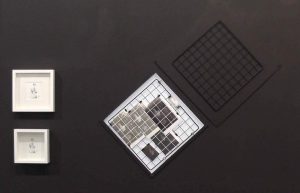
Detail of installation with framed digital prints and analogue photographic test strips clipped to a mesh grid
I was privileged to be entrusted with the Museum’s 1950s Rolleiflex camera.
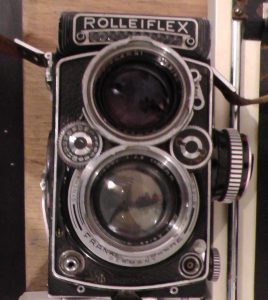
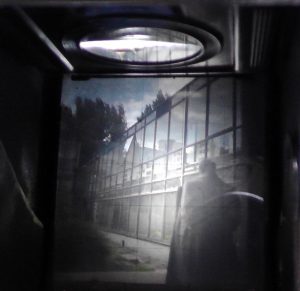


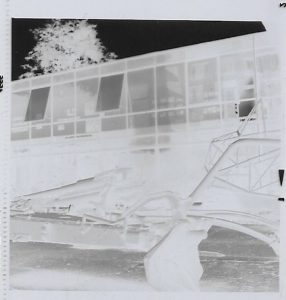
‘The Living Museum’ Open Call workshop, History Museum of BiH, Sarajevo, 27 May 2019
A new phase of ‘Art & Reconciliation’ has started with the launch of the History Museum’s Open Call for our joint follow-on project ‘The Living Museum’. This open call is both a call which is open to all artists/art historians/researchers, and a call to open up the Museum’s art collection, and to open up the question of the Yugoslav/socialist legacy. The call is conceived as an intervention to re-examine the role of art from the period since 1945 until 1989, and its relevance to the contemporary situation there. The results of the selected curatorial and artistic proposals will be presented in an exhibition at the Museum in November 2019.


‘Champ de Mars (Chant de Mars)’ in Venice during the 2019 Biennale
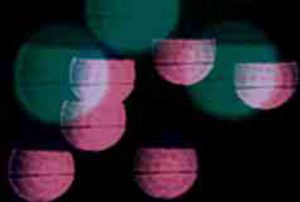
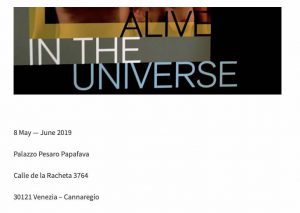
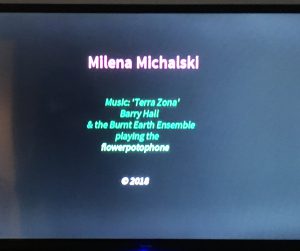
I am currently showing work in a spectacularly different setting, as part of a different project. My (very) short film ‘Champ de Mars (Chant de Mars)’ is being screened during the Venice Biennale, at the Palazzo Pesaro Papafava, as part of Caroline Wiseman’s ‘Alive in the Universe’ event. ‘Champ de Mars’ is an abstracted play of light and colour, linked to art and war both in its title, and in its forms of dancing and fighting circles of light. Other works being shown include those of my fellow former artists in residence at Caroline Wiseman’s Aldeburgh Beach Lookout, such as Lynn Dennison and Nigel Hall. There will also be themed days presided over by artists including Sarah Lucas with Julian Simmons, whose day is on ‘Death’, and Issam Kourbaj, who is himself a refugee from Syria, exploring ‘Life Force’ – what it is that makes a person risk their life by sailing in an inadequate boat to reach a new life.
Reconciliations: The Evidence of the Visible
6-19 March 2019, PARC, London College of Communication, University of the Arts London
Professor Paul Lowe, one of our ‘Art & Reconciliation’ project team, has curated the exhibition ‘Reconciliations: The Evidence of the Visible’, at PARC (Photography and the Archive Research Centre), at the London College of Communication, University of the Arts London. This exhibition explores how visual evidence of past crimes can play a role in post conflict remembrance, reconciliation and rebuilding. For this I am showing a series of photographs I took at the former ‘Dutchbat’ headquarters in the old battery factory in Potočari, near Srebrenica in Bosnia.
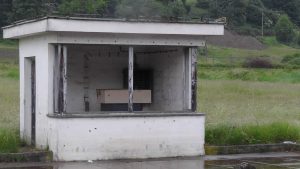
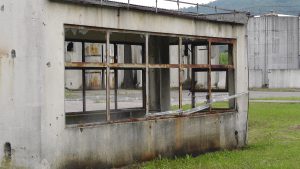
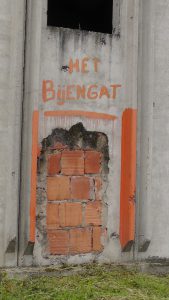
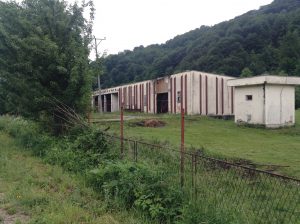

These works are part of my ‘In/visible War Crimes Sites’, an ongoing series of artworks emerging from academic work on conflict and images, around the salience of visual material in transitional justice and its potential for reconciliation, and issues of memorialisation.
The exhibition, which was opened by Lord Owen, also includes very powerful works by Paul Coldwell, Ziyah Gafić, Vladimir Miladinović and Armin Smailović.
Grid References
31 January – 16 April 2019, Liddell Hart cabinets, King’s College London, Strand
‘Grid References: Co-Researching for Innovation and Change’ is an offshoot project from ‘Art & Reconciliation’. It is a collaboration between King’s College London’s Department of War Studies, with Professor James Gow, Dr. Jan Willem Honig working with me and the artist Nicholas Cheeseman, supported by the Cultural Institute at King’s. This project challenges the prevalent researcher-artist nexus, as it has developed in relation to security studies. Rather than artistic production occurring in response to, or as an add-on, to research, a more equitable approach is used, jointly developing research questions. ‘Grid References’ explores how artists’ initiatives and questions can inform research on war; collaboratively investigates military targeting and aerial, or digital, identification; interrogates notions – and visions – of ‘comfortable’ and ‘uncomfortable’ war, and the character of contemporary warfare and political violence; and explores how creative artefacts and processes can actually inform research, as well as enhance it visually.
The project has several phases of exhibitions, and ongoing research.
In January 2019 each of the two cabinets have displays by different artists. The left cabinet features my ‘Grid References’ work, including prints and a glass sculpture, relating to aerial bombing. Some of my prints are adapted from 1959 film footage of Ladybower Reservoir during a drought, showing how a landscape can become abstracted, and its many layers of significant history are visually obscured. I have also included reproductions of Liddell Hart Archival artefacts: a composite print of WWII aerial views of Germany, and a photograph of a stereoscopic glass plate of the Sorpe Dam ruins (15.10.1944).
The right cabinet includes prints and drawings by the artist Nicholas Cheeseman, inspired by the engravings and prints of Frans Hogenberg and Jan Luyken (‘Maastricht Ingenomen door Parma’, 1579, and ‘De Stadt Maastricht, door den prins van Parma met storm verorvert’, 1679, respectively), copies of which are displayed there too. The display is a visual extension of the verbal discussions around the siege of Maastricht that took place amongst the Grid References project team.
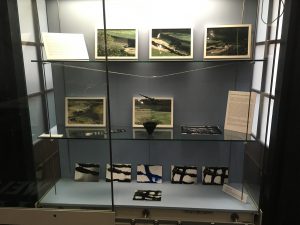
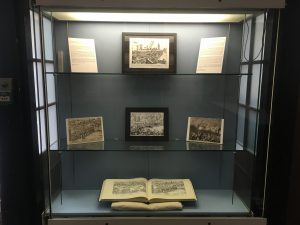
‘Reconciliations and References’
For April 2019 I have created an installation, ‘Reconciliations and References’, looking at a different aspect of art and conflict, through commemoration of the centenary of the founding of the Bauhaus (April 1919). The focus is on the Dessau period, and on links between the Junkers factory and the Bauhaus school there. Architectural prints and photographs of the Bauhaus in Dessau are offset by three suspended model aircraft (including a Junkers war plane), reflecting the contrasting, but intertwined destinies of the site, and embracing the creative quest for simplicity and harmony in design, on one side, and the creative ingenuity involved in designing for destruction, as well as the darkness of the Nazi era, on the other. My prints of the Bauhaus-Archiv building in Berlin are set alongside the Dessau works, as are prints of London’s ‘Isokon’, the modernist flats in Lawn Road, to which Bauhaus founder Walter Gropius, László Moholy-Nagy and Marcel Breuer all fled from Nazi Germany.

Other recent related events
‘Reconciliations VII‘, acrylic, collage, pigment ink on glass
November and December are a whirl of exhibitions, in addition to our project ‘Reconciliations’ exhibition. In November ‘harmonics & functions’ was selected for the ING Discerning Eye 2018 exhibition, at Mall Galleries, and ‘Vortextual Composition No. 6’ for ASC 40 Celsius, in the newly opened Croydon Art House. ‘Reconciliations VII’, a collage-painting piece, is showing in Second Floor Studios Painting Open, in Deptford, opening tomorrow. On Saturday, ‘Champ de Mars (Chant de Mars)’ is screening as part of Caroline Wiseman’s ‘Alive in the Universe’ art films (pre-Venice Biennale 2019), at Bermondsey Project Space.
ENO Baylis event on Benjamin Britten’s War Requiem – 22 October 2018, 17.45-18.30pm
English National Opera, London Coliseum, St Martin’s Lane, London
Hosted by music journalist and critic Alexandra Coughlan, with ENO Music Director Martyn Brabbins, ENO Staff Director for Salome, Elaine Tyler-Hall, and me
(pictured from right to left)
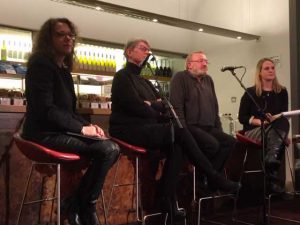
Soundcloud link:
https://www.eno.org/whats-on/pre-performance-talks-2018-19-2/
War Requiem by Benjamin Britten at the ENO
On 22 November 2018 I will be taking part in a pre-performance talk at the ENO with journalist Alexandra Coghlan; Martyn Brabbins, conductor and ENO Musical Director and Elaine Tyler-Hall, ENO staff director.
This is a very special production, as Turner Prize-winning artist and designer Wolfgang Tillmans is part of the creative team. According to the ENO, their ‘Music Director Martyn Brabbins conducts this new production created to mark the centenary of the end of the First World War. ENO Artistic Director Daniel Kramer’s contemporary staging seeks to examine and process the grief of the incomprehensible loss of life from wars past and present, offering us all a hope for the future.’
I am looking forward to seeing and discussing this greatly, as it sounds excellent.
Exhibition poster designed by Roger Walton Studio featuring my ‘Reconciliations I’
Reconciliations exhibition, London: the Exchange & the Knapp Gallery
‘Reconciliations’ is a two-part exhibition running in parallel at the Exchange, Bush House, King’s College London, and at the Knapp Gallery, Regent’s University London. The exhibition offers a chance to see the specific project art commissions, as well as other works relating to the broader concept of ‘reconciliation’, and it also includes works created during a student print workshop held at the Knapp Gallery.
For this exhibition my Sarajevo works came back to London, and were displayed in a new way. I also showed some older works, as well as some new pieces from the ‘Reconciliations’ series, this time based around photographs I had taken in June in Sarajevo of the broken stained glass at the History Museum.
‘Reconciliations III’ at the Exchange and various of my works at the Knapp Gallery


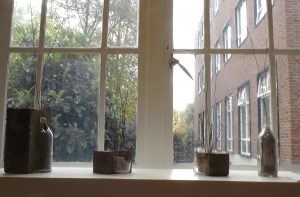

‘Reconciliation after War: a conversation’
On 8th November Professor James Gow gave a presentation on ‘Reconciliation after War’, as part of a series of talks on reconciliation, at St. Mary Abbots Centre, Vicarage Gate, London. We decided that this would work best as a conversation, originally intended to be between him and Dr. Rachel Kerr, but unfortunately Rachel was unable to make it. I stepped in, and the conversation took a different turn than it might have with Rachel, perhaps slightly more art-based and personal, but it was certainly engagingly received and we had very positive responses. For me it was a very rewarding experience, as the audience was made up of a public which was diverse in many ways, and therefore the conversation with the audience covered a far wider range of life experiences and issues than it might have done in a more traditional university setting. It was refreshing to talk about our exhibitions with people who had no prior knowledge of the project.
‘Art and Reconciliation: a conversation’
On 7th November I hosted a wonderful evening at the Exchange ‘Art and Reconciliation: A Conversation’, which involved 5 artists presenting their reconciliation-related work. Painter Gunther Herbst discussed his paintings practice in relation to South Africa, apartheid and modernism, looking at the effects of ‘displacement’ in relationship to visual representation. Dr. Lola Frost talked about how her painting practice engages with the tradition of sublime landscape painting, insofar as it delivers a critique of phallocentric interests through a reconfiguration of psychosexual differences. Filmmaker and artist Naresh Kaushal presented his new film about regeneration in East London. Artist Pam Skelton showed extracts from her video installation work in progress ‘Between Neighbours’, which imagines an exploration of what dialogue is in situations of war and conflict. Sculptor Emma Elliott concluded by showing her concept video about her ‘Reconciliation’ project – a large marble sculpture of a man’s arm, with stigmata and an Auschwitz tattoo number, bringing together the Holocaust and the crucifixion of Jesus Christ – and reflects on the connection between atrocities past and present.
The evening provoked a great deal of animated discussion across a wide range of topics.
REconciliations exhibition, Sarajevo
I created some sculptural pieces for the project’s ‘REconciliations’ exhibition at the History Museum of Sarajevo, in Bosnia and Hercegovina, in June 2018. I also showed some work which relates to the project, but had been made earlier. Alongside the exhibition, we also arranged a symposium and various workshops and events. It was a great privilege to meet so many local and international artists, and to get a chance to work with the museum and its staff.
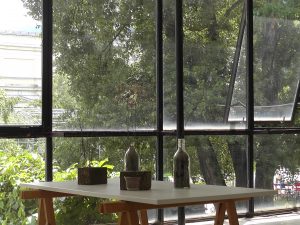


Safe Water for Sarajevo, glass, concrete, wire, 2018
‘Safe Water for Sarajevo’ is a line from an article in the New York Times about the provision of clean water to homes during the siege of Sarajevo, in which ‘safe’ refers to the purity of the water, but also to not having to dodge snipers. In this installation, the crumbling concrete, protruding wires and broken glass allude to architectural ruins, while at the same time the glasses and bottles suggest a domestic setting for socialising — all made impossible.

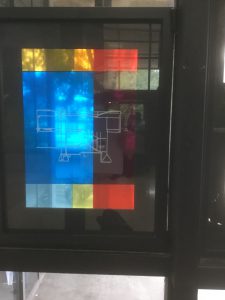
Reconciliations I & II Reconciliations III
pigment ink prints acetate collage, drawing with paint pen on glass
This series of prints and collage/drawings is an ongoing series. ‘Reconciliations I’ and ‘Reconciliations II’ were created before the exhibition, by photographing layers of illuminated coloured acetate. The prints reveal the effects of juxtaposition, of superimposition, of light and dark, translucency and opacity. In doing so they suggest a kind of conversation (whether between the material, colour and light, or between individuals, or communities), as well as echoing stained glass window memorials.
‘Reconciliations III’ is created as a dialogue with the History Museum of Bosnia and Hercegovina, Sarajevo – specifically with the centrepiece in the entrance, the stained glass artwork by Vojo Dimitrijević. My work features an abstracted drawing from an architectural plan of the Museum, on acetate collage. It is a direct piece, not being a photograph of acetate but the actual, acetate itself, and during the exhibition it was installed next to Dimitrijević’s war-ravaged glass.
‘Reconciliations III’ returned to London for our ‘Reconciliations’ exhibition at the Exchange, Bush House, November – December, but will then go back to be part of the permanent collection at the History Museum in Sarajevo, I am thrilled to say.
Abandon all hope
Digital print on acetate, wooden frame with glass, 29 x 24 x 2 cms
This work has been selected for ‘DOORWAYS’, part of the 2018 FaB Festival in Bath. The exhibition is curated by Mike & Dona Bradley; 25 May – 10 June at 7 New Bond Street Place, Bath.
The title ‘Abandon all hope’ refers to the phrase ‘Abandon all hope, ye who enter here’, which Dante places at the gates to hell in Canto III of his ‘Divine Comedy’. In the epic poem, hell is a realm full of those who have given in to the temptation to commit evil, such as brutal violence, or acts of malice, towards others.
I took this photograph of the doorway to the Pathology Block at Sachsenhausen Concentration Camp in Germany. The camp was built in 1936 and was designed and planned by SS architects to be the ‘ideal’ camp, intended to express their world view through its architecture. Between 1936 and 1945, more than 200,000 people were imprisoned in Sachsenhausen.
The doorway to the Pathology Block is built above the Mortuary Cellar, which was used to house bodies prior to cremation. The dilapidated state of the wooden doorway is emphasized in my work by the halftone print technique I have used. The loss of detail in the image relates to the loss of information – it is impossible to know what evil lay beyond this doorway, or even where the door itself is located, without further explanation. The doors in the image are casually open, allowing contemporary visitors to the camp to see inside, and even step inside, whereas during the time of their original use their opening and closing would have been extremely controlled. This doorway was the threshold to inconceivable horrors, yet now, and out of context, it looks banal and commonplace. An innocuous title to this work would have obscured further what it actually represents.
BABEL NEWS
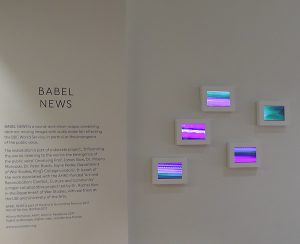
Digital audioscape, digital video, wooden box frames, 9.38 mins. (looped)
Bush House Arcade, London, 9 October 2017 – 31 January 2018
BABEL NEWS was the first artwork (along with photographs by Bogdan Frymorgan) to be exhibited in the newly opened Arcade Space at Bush House, in 2017. It was a real privilege to have my installation there.
BABEL NEWS was commissioned as part of the 2017 Arts & Humanities Festival, on the theme of ‘World Service’. This idea was interpreted both broadly conceptually, and literally, in terms of the BBC World Service. It formed part of a broader project ‘Influencing the World, Listening to the World: the Emergence of the Public Voice’, which included a panel discussion about how wars and major international issues are presented and discussed, the language used, and themes such as propaganda, spin and fake news that communicate these issues.
‘The BBC World Service has been pivotal in reporting global conflict for almost eight decades. The acquisition of its former home, Bush House, by King’s, gives us an opportunity to explore the ways in which news reporting, strategic communication, public discussion and engagement, the very idea of global service in the broadest sense, audio-visual (radio-television) balances, the place of audiences and publics, and attitudes to key global issues have changed, since the BBC World Service began to broadcast in 1932.’
The panel included Emily Kasriel, BBC World Service, Professor Sir Lawrence Freedman, King’s College London, Dr. Nicholas Michelsen, King’s College London, Professor Marie Gillespie, Open University, and Dr. Neville Bolt, Editor-in-Chief Defence Strategic Communications.
BABEL NEWS itself features an ‘audioscape’, composed by layering extracts from the following BBC programmes:
WORLD HAVE YOUR SAY
‘A New Life’ presented by Ben James
‘Libya: The people’s war’ presented by Ros Atkins
THE FORUM
‘Images’ presented by David Baddiel, featuring Prof. James Gow
‘Reconciliation – healing the nation’ presented by Bridget Kendall
‘Invisibility’ presented by Samira Ahmed
These have been overlaid, and volumes altered, to weave a tapestry of voices which are sometimes clearly audible, with distinct phrases standing out, yet which, at other times, merge into an indecipherable babble of sound.


In terms of the visual, too, there are multiple layers, which merge at times to form a complex surface, and at others reveal themselves clearly as a single image. These include images of digital sound waves, analogue television glitches, drawn-on photographs and more.
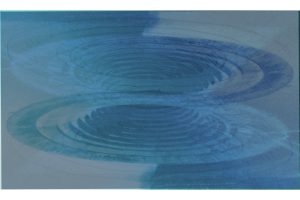
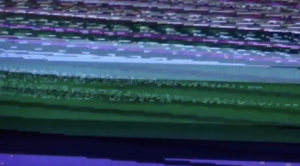
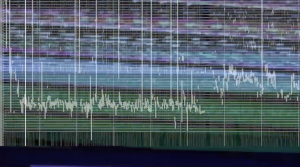
BABEL NEWS was supposed to come down at then of the Festival, but it worked so well in the space that the King’s Cultural Institute decided to keep it in place as long as possible, until the end of January 2018.
For more on this installation listen to the KCL podcast on Soundcloud: https://soundcloud.com/warstudies/art-and-reconciliation
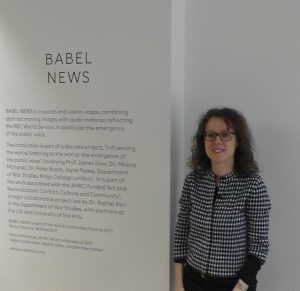

‘Artists, artistic practices and reconciliation’
Artists discussion on the role of art in reconciliation, convened by Milena Michalski, Somerset House Studios, 28 January 2018
PODCAST LINK RELATING TO THE EVENT:
https://soundcloud.com/warstudies/art-and-reconciliation
NOTES ON THE EVENTS
Participating artists, along with me:
Emma Elliott: a sculptor, whose work ‘Reconciliation’ relates to the Holocaust, whilst also referencing the crucifixion of Jesus Christ. http://www.emmaelliott.com/work
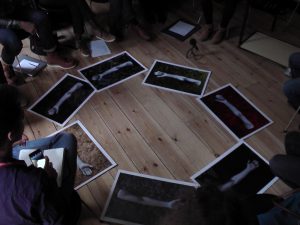
Alketa Xhafa Mripa: a conceptual artist who created ‘Thinking of You’, in which she filled a football stadium in Kosovo with dresses to remember victims of war rape. Discussing her installation ‘Refugees Welcome’, in 2016, Alketa said: ‘Art may not be a solution for the millions of people in the world who have lost their homes. But I believe that art can make the issue of refugees visible, in a way that is understood by all, regardless of faith, nationality or language. Where language fails, art can break through.’ http://www.tracesproject.org/alketa-xhafa-mripa
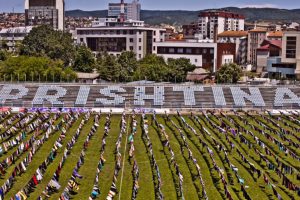
Gunther Herbst: a painter who works with ideas around memory, memorialisation and monuments in South Africa.
https://www.guntherherbst.com
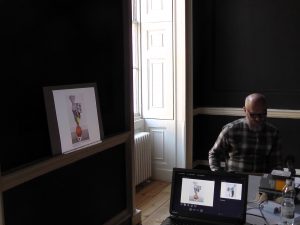
Naresh Kaushal: filmmaker and photographer, whose practice involves bringing stories and experiences from the real world to life and encompasses both documentary and abstract techniques. https://www.camerawala.org/about
Art on Conflict
Soldiers of Oxfordshire Museum, Woodstock
28 September – 26 October 2017
I was invited to exhibit in this international group show on conflict because of my work on war crimes sites and other political and military conflicts, but l was keen be part of it specifically because I was interested in its broader understanding of ‘conflict’ – as something which can be between individuals, between communities or countries, for example, but also as something internal, within an individual, and specifically here, within the artist. This fits precisely with my own thinking in the context of our ‘Art & Reconciliation’ project, where I am also considering issues of reconciliation within oneself, as well as within communities, and again – with specific reference to the arts.
‘Art on Conflict’ took place in the ‘Soldiers of Oxfordshire Museum’, as part of the Wake up to Woodstock Festival, curated to complement and reflect the themes of power, conflict and activism in Jenny Holzer’s show and night time projection at Blenheim Palace, ‘Softer’.
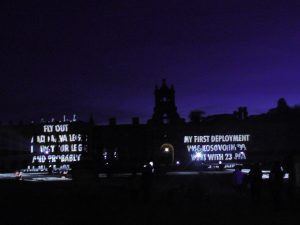
The museum, which is very near the Palace, in a lovely, leafy setting, is small but rich in content, and a real pleasure to show in, thanks to Dennis Allen, Rod Craig and Jenny Kelly. I showed 4 separate works, spanning from 2012 to 2017, including a new iteration of my ongoing sculptural installation series, ‘Two Towers’, as well as a unique print loaned by King’s College London, ‘Scene/Unseen’.
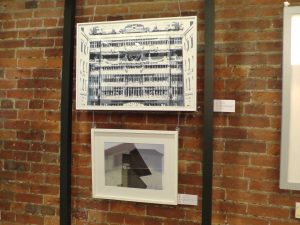

All the works in the exhibition were selected ‘to reflect artistic, personal and historical conflicts’, including very recent ones, as in the powerful and imposing pieces by the Syrian painter, Sara Shamma.
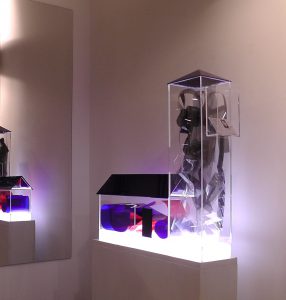
I specifically chose a place right by the mirror for my transparent and translucent sculptural installation, ‘Two Towers Talk’, as it introduced an additional reflective facet to its element of light play.
For me, one of the highlights of this exhibition was ‘Waterproof’, a beautiful film by and about Graham Dean’s paintings and processes. It is his painting that was used on the exhibition poster.
The Oxford Times published a feature on the exhibition, which can be accessed here:
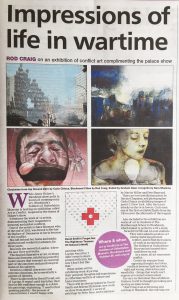
‘Looking In, Looking Out’
King’s College London with the Freud Museum London, 13 September – 31 October
Installation created for the exhibition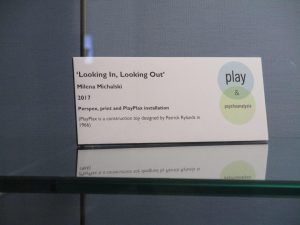
‘Anna Freud and Play’
My installation ‘Looking In, Looking Out’ comprises three parts: two prints and a sculptural, perspex piece incorporating print within it.
The installation treats issues of home and exile, of protection and threat, of visibility and invisibility.
It relates both to Anna Freud (and Sigmund Freud) as a refugee, and to my own family history, and by extension to general issues of home, flight, exile, refuge, and questions of reconciliation between past, present and future.
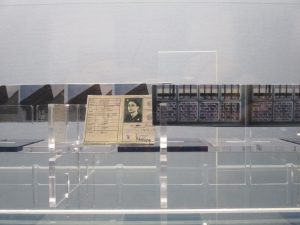
The overall theme of the exhibition was ‘Anna Freud and Play’, so for this piece I created an iteration of my ongoing series of acrylic architectural constructions, this time incorporating pieces of the children’s classic building toy ‘PlayPlax’, designed by Patrick Rylands in 1966. Like my construction, ‘PlayPlax’ is made of transparent or translucent Perspex.
The two accompanying, yet discrete, prints, ’Duality’ and ‘Looking In, Looking Out’, each interweave two places, times and themes. Both are created by superimposing two photographs, in one doors, in the other windows, in the Freud family house. One set of doors and windows is at Berggasse 19, Vienna, Austria, where Freud lived and worked from 1891 until 1938, when he and his family were forced into exile by the National Socialists. The second sets are at 20, Maresfield Gardens, London, UK, where the family fled to, and which remained the family home until Anna Freud, the youngest daughter, died in 1982. Both Sigmund and Anna Freud worked here too.
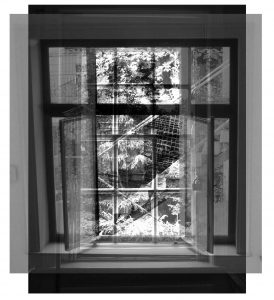
‘Ruins of Time / Asylum’
Exhibition at Asylum Chapel, Caroline Gardens, Asylum Road, London
28-31 March 2017
This exhibition is part of the ongoing ‘Ruins of Time’ series of exhibitions, part of the London-Munich exchange.
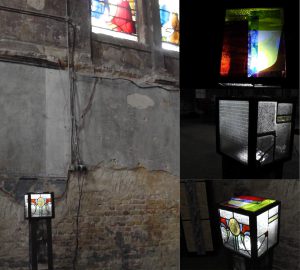
The three works showing at Asylum – ‘Disintegrating’, ‘Unveiled’ and ‘Abandoned’ – were created specifically for the site. The over-arching theme is the concept of ‘asylum’, in all its meanings, and, inherent within it, its opposite. These works are an attempt to reconcile the building’s past uses and fate during the war with its current functions as an arts venue, amongst other uses.
On the simplest level, the works refer to the fabric of the former chapel itself, in its captivating state of partial decay. This is both a reflection on time passing, life and death, and a reference to the chapel having been part of a place of retirement, worship and funerals for ‘decayed members’ of the victuallers trade. On another level, it references the bomb damage dating from the second world war, which destroyed the roof and left the stained glass windows broken in places.

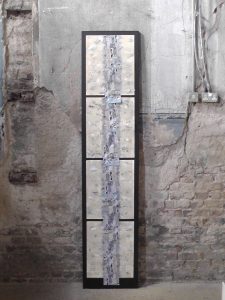
The three works all focus on architectural elements, whether a rotting plain window and disintegrating wall, a smashed, coloured, stained glass window or fragments of plaster and paint. These parts of a building are pitifully inadequate at providing any protection, as they were originally intended to do; they have become decorative yet disturbing, reminders of times, places and people long since gone. They function only as metaphors. These works created for Asylum amplify these ideas further, by alluding to the chapel’s physical decrepitude, and the adoption of the site as a venue in which its functional failures have become aesthetic ‘assets’.
